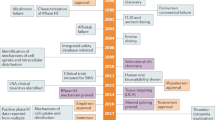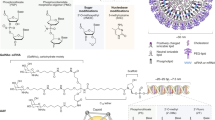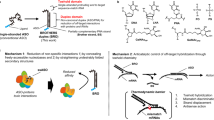Abstract
About 25 years ago, researchers first demonstrated that a short synthetic oligodeoxynucleotide, referred to as antisense, can inhibit replication of Rous sarcoma virus through hybridization to viral RNA. Since then, several hybridization-based oligonucleotide approaches have been developed to elucidate the functions of genes and their potential as therapeutic agents. Short-interfering (si) RNA is the most recent example. To effectively inhibit gene expression, an antisense or siRNA must be resistant to nucleases, be taken up efficiently by cells, hybridize efficiently with the target mRNA and activate selective degradation of the target mRNA or block its translation without causing undesirable side effects. However, both antisense and siRNA agents have been shown to exert non-target-related biological effects including immune stimulation. Do antisense and siRNA agents work as ligands for Toll-like receptors (TLRs), a family of pathogen-associated, molecular pattern recognition receptors?
This is a preview of subscription content, access via your institution
Access options
Subscribe to this journal
Receive 12 print issues and online access
$209.00 per year
only $17.42 per issue
Buy this article
- Purchase on Springer Link
- Instant access to full article PDF
Prices may be subject to local taxes which are calculated during checkout

Similar content being viewed by others
Change history
01 January 2005
Nat. Biotechnol. 22, 1533–1537 (2004) The title should read, “Role of Toll-like receptors in antisense and siRNA.” The last line of paragraph 3, beginning “This article summarizes present evidence....” should be deleted. In Table 1, superscript 'b' in “Sequencea,b, should be deleted, and superscript'a' after 3′ in line 3 of that column should be replaced by superscript b.
References
Zamecnik, P.C. & Stephenson, M.L. Inhibition of Rous sarcoma virus replication and cell transformation by a specific oligodeoxynucleotide. Proc. Natl. Acad. Sci. USA 75, 280–284 (1978).
Agrawal, S. et al. Oligodeoxynucleoside phosphoramidates and phosphorothioates as inhibitors of human immunodeficiency virus. Proc. Natl. Acad. Sci. USA 85, 7079–7083 (1988).
Agrawal, S. & Kandimalla, E.R. Antisense therapeutics: is it as simple as complementary base recognition? Mol. Med. Today 6, 72–81 (2000).
Sereni, D. et al. Pharmacokinetics and tolerability of intravenous trecovirsen (GEM 91), an antisense phosphorothioate oligonucleotide, in HIV-positive subjects. J. Clin. Pharmacol. 39, 47–54 (1999).
Vitravene study group. A randomized controlled clinical trial of intravitreous fomivirsen for treatment of newly diagnosed peripheral cytomegalovirus retinitis in patients with AIDS. Am. J. Ophthalmol. 133, 467–474 (2002).
Webb, A. et al. Bcl2 antisense therapy in patients with non-Hodgkin lymphoma. Lancet 349, 1137–1141 (1997).
Cunningham, C.C. et al. A phase I trial of H-ras antisense oligonucleotide ISIS2503 administered as a continuous intravenous infusion in patients with advanced carcinoma. Cancer 92, 1265–1271 (2001).
Nemunaitis, J. et al. Phase I evaluation of ISIS3521, and antisense oligodeoxynucleotide to protein kinase C-α, in patients with advanced cancer. J. Clin. Oncol. 17, 3586–3595 (1999).
O'Dwyer, P.J. et al. c-raf-1 depletion and tumor responses in patients treated with the c-raf-1 antisense oligodeoxynucleotide ISIS5132 (CGP69846A). Clin. Cancer Res. 5, 3977–3982 (1999).
Bishop, M.R. et al. Phase I trial of an antisense OL(1)p53 in hematologic malignancies. J. Clin. Oncol. 14, 1320–1326 (1996).
Andrews, D.W. et al. Results of a pilot study involoving the use of an antisense oligodeoxynucleotide directed against the insulin-like growth factor type 1 receptor in malignant astrocytomas. J. Clin. Oncol. 19, 2189–2200 (2001).
Luger, S.M. et al. Oligodeoxynucleotide-mediated inhibition of c-myb gene expression in autografted bone marrow: a pilot study. Blood 99, 1150–1158 (2002).
Lee, Y. et al. GTI-2040, an antisense agent targeting the small subunit component (R2) of human ribonucleotide reductase, shows potent antitumor activity against a variety of tumors. Cancer Res. 63, 2802–2811 (2003).
Levine, A.M., Quinn, D.I., Gorospe, G., Lenz, H.J. & Tulpule, A. Phase I trial of antisense oligonucleotide vascular endothelial growth factor (VEGF-AS, Veglin) in patients with relapsed and refractory malignancies. Abstract #3008, ASCO Annual Meeting (2004).
Kutryk, M.J. et al. Locan intracoronary administration of antisense oligonucleotide against c-myc for the prevention of in-stent resenosis: results of the randomized investigation by the Thoraxcenter of antisense DNA using local delivery and IVUS after coronary stenting (ITALICS) trial. J. Am. Coll. Cardiol. 39, 281–287 (2002).
Schreiber, S. et al. Absence of efficacy of subcutaneous antisense ICAM-1 treatment of chronic active Chron's disease. Gastroenterology 120, 1339–1346 (2001).
Tanaka, M. & Nyce, J.W. Respirable antisense oligonucleotides: a new drug class for respiratory disease. Respir. Res. 2, 5–9 (2001).
Tamm, I., Dorken, B. & Hartmann, G. Antisense therapy in oncology: new hope for an old idea? Lancet 358, 489–497 (2001).
Lewis, E.J. et al. Non-specific antiviral activity of antisense molecules targeted to the E1 region of human papillomavirus. Antiviral Res. 48, 187–196 (2000).
Lisziewicz, J. et al. Antisense oligodeoxynucleotide phosphorothioate complementary to Gag mRNA blocks replication of human immunodeficiency virus type 1 in human peripheral blood cells. Proc. Natl. Acad. Sci. USA 91, 7942–7946 (1994).
Zhang, R. et al. Pharmacokinetics and tissue distribution in rats of an oligodeoxynucleotide phosphorothioate (GEM 91) developed as a therapeutic agent for human immunodeficiency virus type-1. Biochem. Pharmacol. 49, 929–939 (1995).
Grindel, J.M., Musick, T.J., Jiang, Z., Roskey, A. & Agrawal, S. Pharmacokinetics and metabolism of an oligodeoxynucleotide phosphorothioate (GEM91) in cynomolgus monkeys following intravenous infusion. Antisense Nucleic Acid Drug Dev. 8, 43–52 (1998).
Agrawal, S. & Martin, R.R. Was induction of HIV-1 through TLR9? J. Immunol. 171, 1621 (2003).
Bafica, A., Scanga, C.A., Schito, M., Chaussabel, D. & Sher, A. Influence of coinfecting pathogens on HIV expression: evidence for a role of Toll-like receptors. J. Immunol. 172, 7229–7234 (2004).
Janssens, S. & Beyaert, R. Role of Toll-like receptors in pathogen recognition. Clin. Microbiol. Rev. 16, 637–646 (2003).
Alexopoulou, L., Holt, A.C., Medzhitov, R. & Flavell, R.A. Recognition of double-stranded RNA and activation of NF-kappaB by Toll-like receptor 3. Nature 413, 732–738 (2001).
Lee, J. et al. Molecular basis for the immunostimulatory activity of guanine nucleoside analogs: activation of Toll-like receptor 7. Proc. Natl. Acad. Sci. USA 100, 6646–6651 (2003).
Kariko, K., Bhuyan, P., Capodici, J. & Weissman, D. Small interfering RNAs mediate sequence-independent gene suppression and induce immune activation by signaling through Toll-like receptor 3. J. Immunol. 172, 6545–6549 (2004).
Heil, F. et al. Species-specific recognition of single-stranded RNA via toll-like receptor 7 and 8. Science 303, 1526–1529 (2004).
Diebold, S.S., Kaisho, T., Hemmi, H., Akira, S. & Reis e Sousa, C. Innate antiviral responses by means of TLR7-mediated recognition of single-stranded RNA. Science 303, 1529–1531 (2004).
Hemmi, H. et al. A Toll-like receptor recognizes bacterial DNA. Nature 408, 740–745 (2000).
Kandimalla, E.R. et al. Conjugation of ligand at the 5′-end of CpG DNA affects immunostimulatory activity. Bioconjug. Chem. 13, 966–974 (2002).
Yu, D. et al. 'Immunomers' —novel 3′-3′-linked CpG oligodeoxyribonucleotides as potent immunomodulatory agents. Nucleic Acids Res. 30, 4460–4469 (2002).
Klinman, D.M. Immunotherapeutic uses of CpG oligodeoxynucleotides. Nat. Rev. Immunol. 4, 249–258 (2004).
Kandimalla, E.R. & Agrawal, S. Agonists of Toll-like receptor 9: modulation of host immune responses with synthetic oligodeoxynucleotides. in Toll-receptors (ed. Rich, T.) 1–32 (Landes Biosciences, Florida, 2004).
Kulka, M., Alexopoulou, L., Flavell, R.A. & Metcalfe, D.D. Activation of mast cells by double-stranded RNA: evidence for activation through Toll-like receptor 3. J. Allergy Clin. Immunol. 114, 174–182 (2004).
Zhao, Q., Temsamani, J., Iadarola, P.L., Jiang, Z. & Agrawal, S. Effect of different chemically modified oligodeoxynucleotides on immune stimulation. Biochem. Pharmacol. 51, 173–182 (1996).
Weiner, G.J., Liu, H.M., Wooldridge, J.E., Dahle, C.E. & Krieg, A.M. Immunostimulatory oligodeoxynucleotides containing the CpG motif are effective as immune adjuvants in tumor antigen immunization. Proc. Natl. Acad. Sci. USA 94, 10833–10837 (1997).
Jahrsdorfer, B. et al. Modulation of malignant B cell activation and apoptosis by bcl-2 antisense ODN and immunostimulatory CpG ODN. J. Leukoc. Biol. 72, 83–92 (2002).
Suhadolnik, R.J. et al. Changes in the 2-5A synthetase/RNase L antiviral pathway in a controlled clinical trial with poly(I)-poly(C12U) in chronic fatigue syndrome. In Vivo 8, 599–604 (1994).
Thompson, K.A. et al. Results of a double-blind placebo-controlled study of the double-stranded RNA drug polyI:polyC12U in the treatment of HIV infection. Eur. J. Clin. Microbiol. Infect. Dis. 15, 580–587 (1996).
Agrawal, S. & Kandimalla, E.R. Modulation of Toll-like Receptor 9 responses through synthetic immunostimulatory motifs of DNA. Ann. NY Acad. Sci. 1002, 30–42 (2003).
Simons, F.E., Shikishima, Y., Van Nest, G., Eiden, J.J. & HayGlass, K.T. Selective immune redirection in humans with ragweed allergy by injecting Amb 1 a linked to immunostimulatory DNA. J. Allergy Clin. Immunol. 113, 1144–1151 (2004).
Halperin, S.A. et al. A phase I study of the safety and immunogenicity of recombinant hepatitis B surface antigen co-administered with an immunostimulatory phosphorothioate oligonucleotide adjuvant. Vaccine 21, 2461–2467 (2003).
Cooper, C.L. et al. Safety and immunogenicity of CpG 7909 injection as an adjuvant to Fluarix influenza vaccine. Vaccine 22, 3136–3143 (2004).
Sullivan, T. et al. Immunological activity of HYB2055, a TLR9 agonist, in healthy volunteers. (abstract no. 4707) Proc. Am. Assoc. Cancer Res. 45, 1087 (2004).
Martin, R. et al. A phase I placebo-controlled study in volunteers of escalating doses of HYB2055, a second-generation immunomodulatory agent based on CpG DNA. AACR-NCI-EORTC International Conference on Molecular Targets and Therapeutics, Boston, MA, November 17–21, 2003, Abstract no. C100 (2003).
Agrawal, S. & Zhao, Q. Antisense therapeutics. Curr. Opin. Chem. Biol. 2, 519–528 (1998).
Galbraith, W.M., Hobson, W.C., Giclas, P.C., Schechter, P.J. & Agrawal, S. Complement activation and hemodynamic changes following intravenous administration of phosphorothioate oligonucleotides in monkey. Antisense Res. Dev. 4, 201–206 (1994).
Mark, G.S. Genta sued over NDA withdrawal. Nat. Biotechnol. 22, 788–789 (2004).
Agrawal, S. et al. Mixed-backbone oligonucleotides as second generation antisense oligonucleotides: in vitro and in vivo studies. Proc. Natl. Acad. Sci. USA 94, 2620–2625 (1997).
Metelev, V., Lisziewicz, J. & Agrawal, S. Study of antisense oligonucleotide phosphorothioate containing segments of oligodeoxynucleotides and 2′-O-methyloligoribonucleotides. Bioorg. Med. Chem. Lett. 4, 2929–2934 (1994).
Zhang, R. et al. In vivo stability, disposition and metabolism of a “hybrid” oligonucleotide phosphorothioate in rats. Biochem. Pharmacol. 50, 545–556 (1995).
Zhou, W. & Agrawal, S. Mixed-backbone oligonucleotides as second-generation antisense agents with reduced phosphorothioate-related side effects. Bioorg. Med. Chem. Lett. 8, 3269–3274 (1998).
Agrawal, S. et al. Absorption, tissue distribution and in vivo stability in rats of a hybrid antisense oligonucleotide following oral administration. Biochem. Pharmacol. 50, 571–576 (1995).
Mani, S. et al. Clinical studies in patients with solid tumors using a second-generation antisense oligonucleotide (GEM 231) targeted against protein kinase type 1. Ann. NY Acad. Sci. 1002, 252–262 (2003).
Sewell, K.L. et al. Phase I trial of ISIS 104838, a 2′-methoxyethyl modified antisense oligonucleotide targeting tumor necrosis factor-α. J. Pharmacol. Exp. Ther. 303, 1334–1343 (2002).
Chi, K.N. et al. A phase I pharmacokinetic (PK) and pharmacodynamic (PD) study of OGX-011, a 2′-methoxyethyl phosphorothioate antisense to clusterin, in patients with prostate cancer prior to radical prostatectomy. (abstract no. 3033), 2004 Annual Meeting of the American Society of Clinical Oncology. http://www.asco.org
Dorsett, Y. & Tuschl, T. siRNAs: applications in functional genomics and potential as therapeutics. Nat. Rev. Drug Discov. 3, 318–329 (2004).
Scacheri, P.C. et al. Short interfering RNAs can induce unexpected and divergent changes in the levels of untargeted proteins in mammalian cells. Proc. Natl. Acad. Sci. USA 101, 1892–1897 (2004).
Jackson, A.L. et al. Expression profiling reveals off-target gene regulation by RNAi. Nat. Biotechnol. 21, 635–637 (2003).
Bridge, A.J., Pebernard, S., Ducraus, A., Nicoulaz, A.L. & Iggo, R. Induction of an interferon response by RNAi vectors in mammalian cells. Nat. Genet. 34, 263–264 (2003).
Sledz, C.A., Holko, M., deVeer, M.J., Silverman, R.H. & Williams, B.R. Activation of the interferon system by short-interfering RNAs. Nat. Cell Biol. 5, 834–839 (2003).
Layzer, J.M. et al. In vivo stability of nuclease-resistant siRNAs. RNA 10, 766–771 (2004).
Braasch, D.A. et al. Biodistribution of phosphodiester and phosphorothioate siRNA. Bioorg. Med. Chem. Lett. 14, 1139–1143 (2004).
Paroo, Z. & Corey, D.R. Challenges for RNAi in vivo. Trends Biotechnol. 22, 390–394 (2004).
Hartman, G. & Krieg, A.M. CpG DNA and LPS induce distinct patterns of activation in human monocytes. Gene Ther. 6, 893–903 (1999).
Davila, E., Velez, M.G., Heppelmann, C.J. & Celis, E. Creating space: an antigen-independent, CpG-induced peripheral expansion of naïve and memory T lymphocytes in a gull T-cell compartment. Blood 100, 2537–2545 (2002).
Kato, A. et al. Intereferon-α/β receptor-mediated selective induction of a gene cluster by CpG oligodeoxynucotide 2006. BMC Immunol. 4, 8–17 (2003).
Author information
Authors and Affiliations
Corresponding author
Ethics declarations
Competing interests
Both authors are employees of Hybridon and have company-offered employee stock options.
Rights and permissions
About this article
Cite this article
Agrawal, S., Kandimalla, E. Antisense and siRNA as agonists of Toll-like receptors. Nat Biotechnol 22, 1533–1537 (2004). https://doi.org/10.1038/nbt1042
Published:
Issue Date:
DOI: https://doi.org/10.1038/nbt1042
This article is cited by
-
Regulation of human microglial gene expression and function via RNAase-H active antisense oligonucleotides in vivo in Alzheimer’s disease
Molecular Neurodegeneration (2024)
-
Antisense Oligonucleotides for the Study and Treatment of ALS
Neurotherapeutics (2022)
-
Modulation of blood-brain barrier function by a heteroduplex oligonucleotide in vivo
Scientific Reports (2018)
-
Inhibition of apelin expression switches endothelial cells from proliferative to mature state in pathological retinal angiogenesis
Angiogenesis (2013)
-
RNAi: a potential new class of therapeutic for human genetic disease
Human Genetics (2011)



